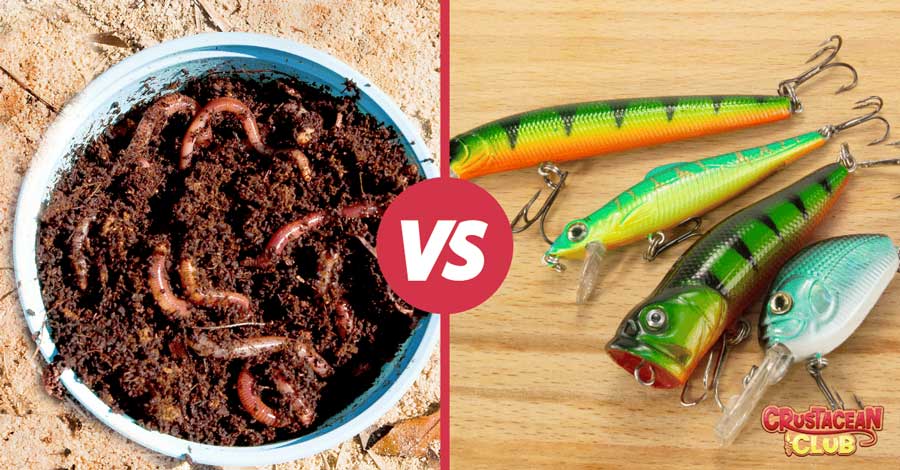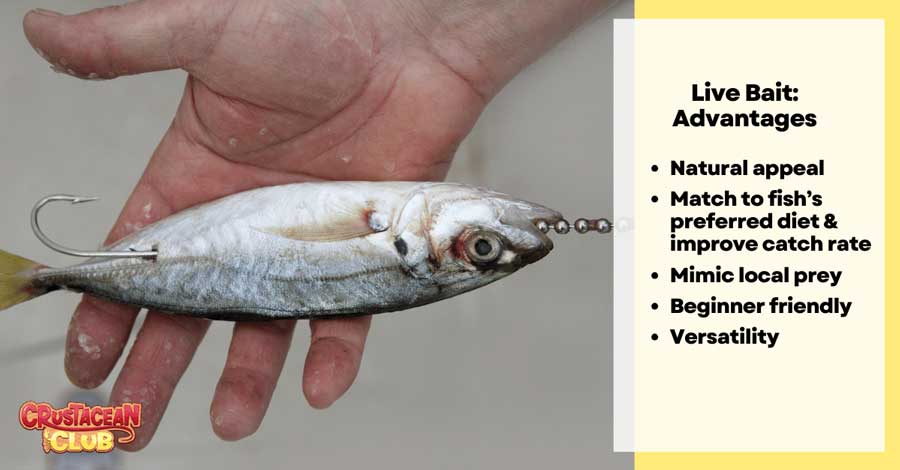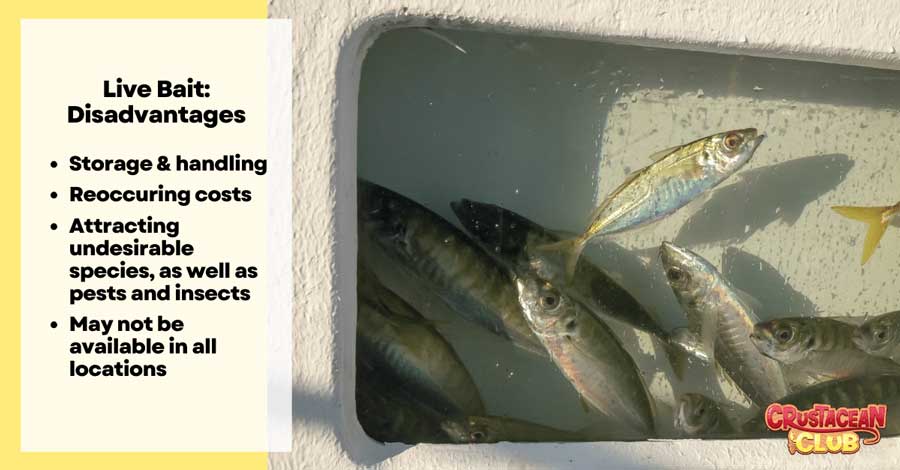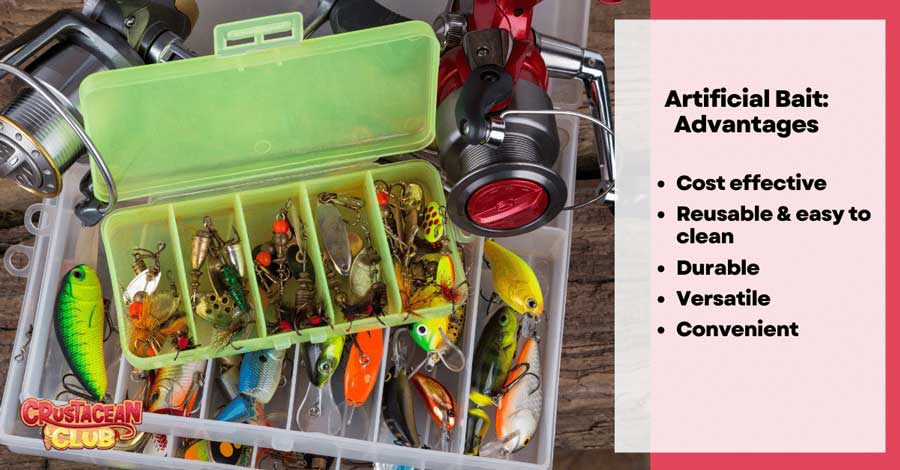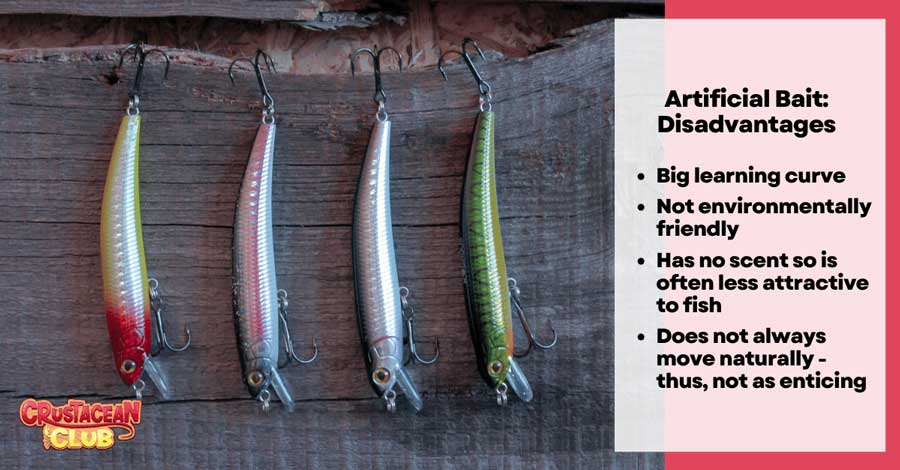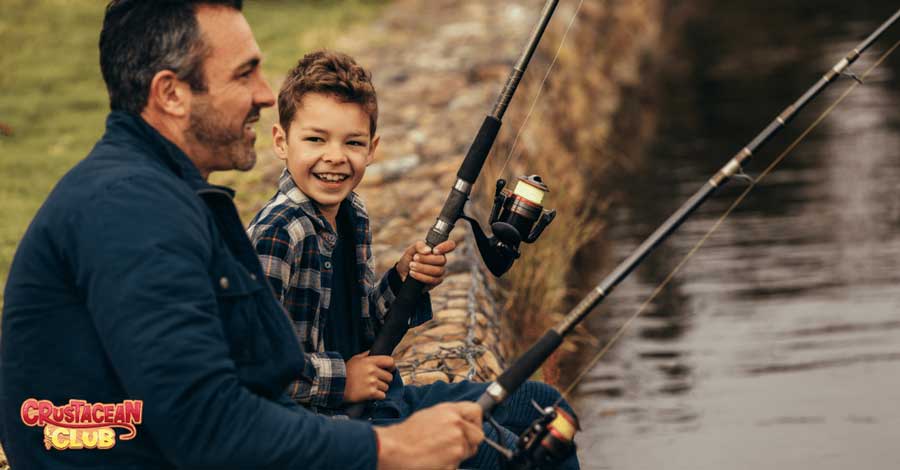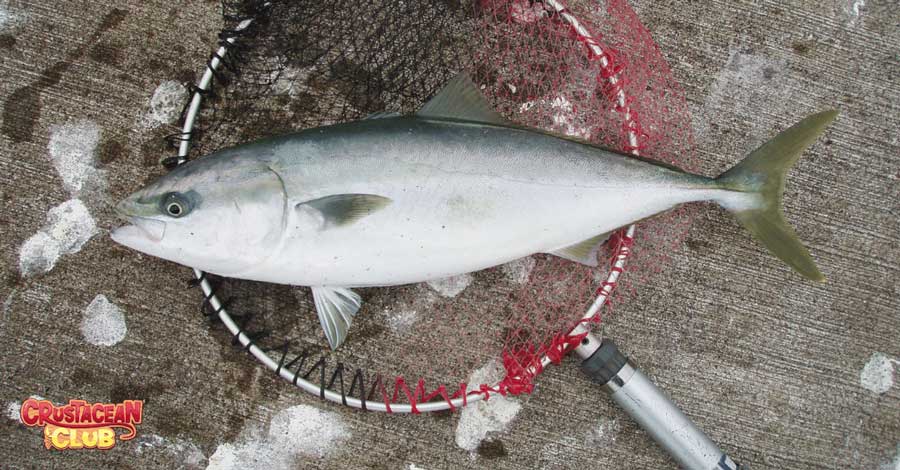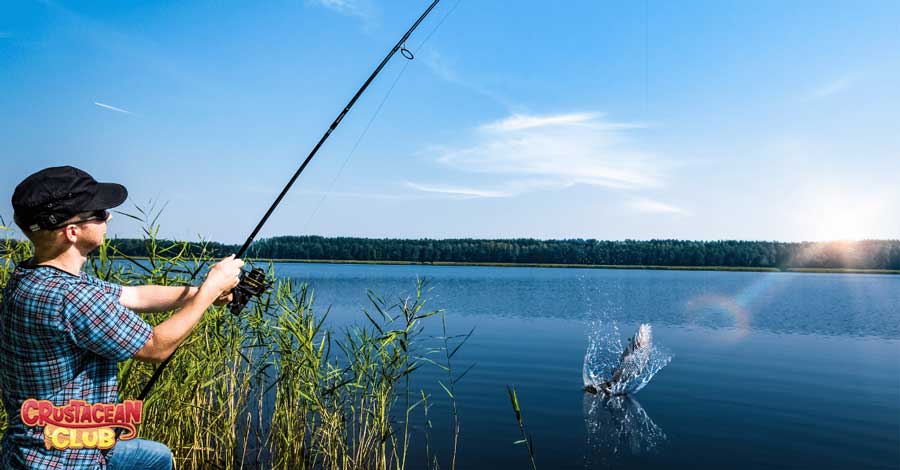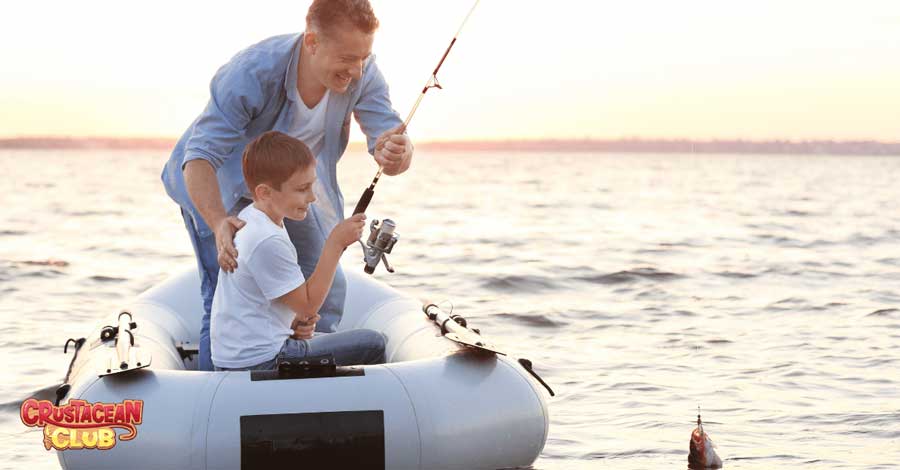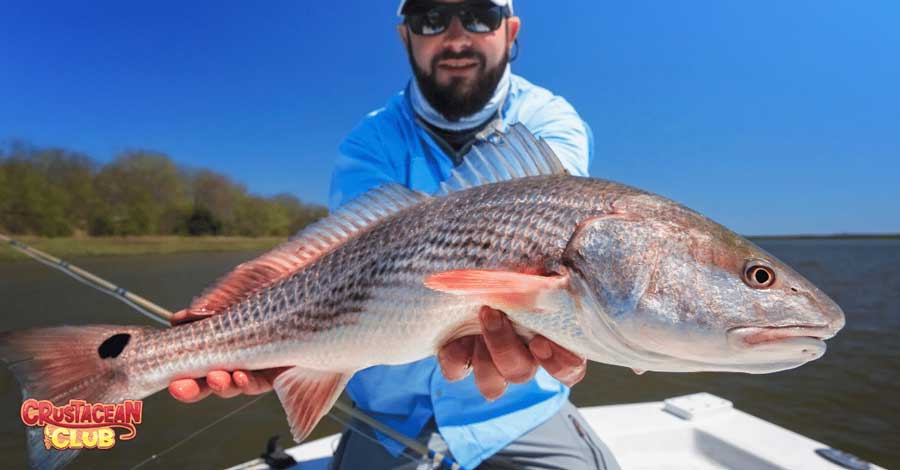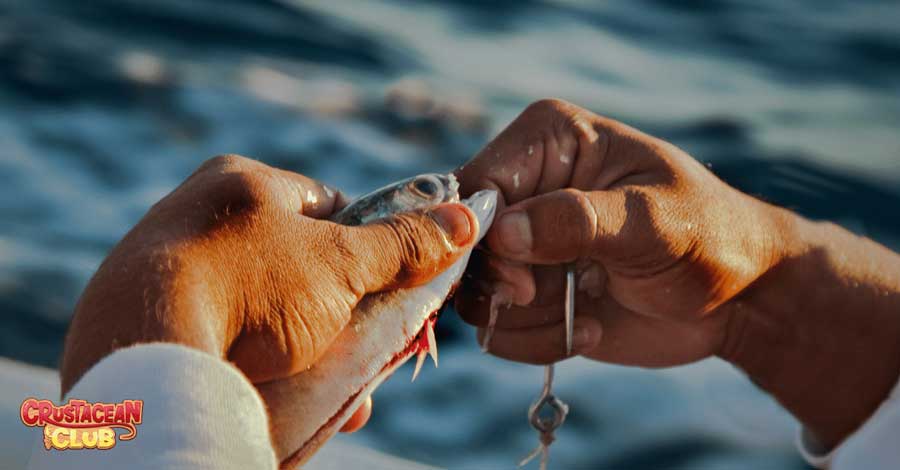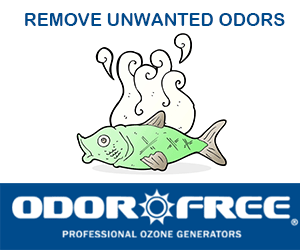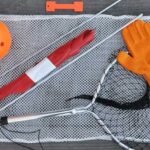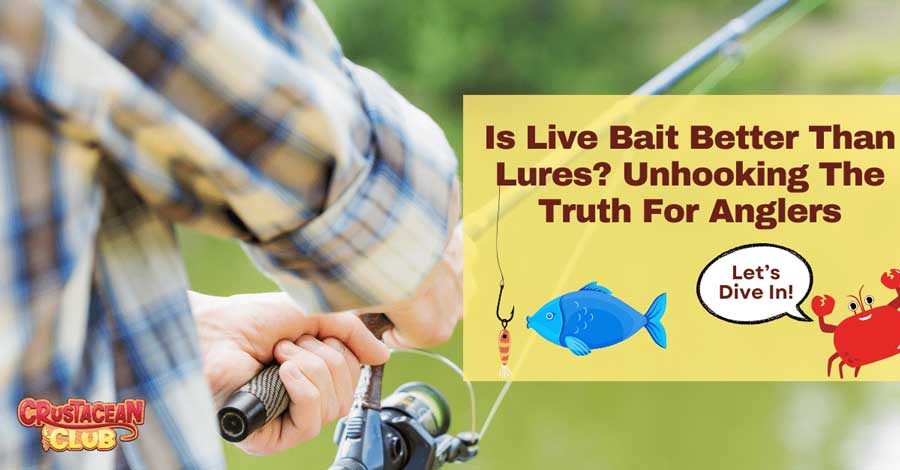
Is live bait better than lures? In the world of angling, tools and tactics can make or break a fishing trip. This article delivers a no-nonsense look at whether live bait or lures serve your goal best, underpinned by practical factors like target species and water conditions. Avoid the bait of guesswork; let’s dive into the evidence that’ll guide your next fishing decision.
For more information on all things crustacean, be sure to check out the Crustacean Club site where you can also find expert guides on lobstering and crabbing!
Key Takeaways
- Both live bait and artificial lures have unique strengths: live bait typically attracts larger fish, while lures can hook more fish and offer reusability and targeting for specific species.
- Choosing between live bait and lures depends on various factors including target fish species, fishing location and conditions, and the angler’s skill level and personal preference.
- Environmental and ethical considerations play a role in the choice of bait: live bait can harm non-target species and ecosystems, while artificial lures contribute to plastic pollution unless responsibly discarded.
We love hearing from our readers and subscribers, so please feel free to reach out and contact us today!
Live Bait vs. Artificial Lures: The Great Debate
The debate between live bait and artificial lures hinges on their effectiveness in catching fish. Are artificial lures superior? Or does live bait reign supreme? This is a question that has ruffled many a fishing hat. Interestingly, research suggests that both have unique strengths.
A study conducted in New Zealand revealed a fascinating nuance in this great debate. It was found that while artificial lures may hook a greater number of fish, live bait has a tendency to attract larger fish. This suggests that the choice between live bait and artificial lures may depend on what you’re after: quantity or size?
It’s also worth noting that the usage of live bait or artificial lures can vary with the type of fishing. For instance, live bait might be more commonly used in bait fishing, while artificial lures might be the go-to option in fly fishing. In essence, the effectiveness of live bait and artificial lures is not black and white but exists in shades of grey.
Advantages of Live Bait
Live bait offers a certain natural appeal that can be hard for fish to resist. Its inherent movement, smell, and texture can be almost irresistible to predatory fish, particularly in new inshore spots. The ability to match live bait to the fish’s preferred diet can significantly improve catch rates. Some fresh, natural baits that mimic local prey and are a surefire way to entice fish include:
- Shrimp
- Minnows
- Crabs
- Worms
Moreover, live bait proves to be an excellent choice for novice anglers. It provides improved chances of success, even when the fishing technique hasn’t been fully refined – check out this beginner guide to fishing. The versatility of live bait, effective across varying conditions, can trigger fish strikes, sometimes even more so than artificial lures. New anglers can attract fish even with imperfect technique, and bait options like worms, minnows, or insects can be tailored to the specific diet preferences of target fish.
Disadvantages of Live Bait
While live bait has its advantages, it’s not without its drawbacks. One key challenge is the storage and handling of live bait. It requires refrigeration for preservation, which can make it cumbersome to store and handle, particularly for extended fishing trips.
Live bait also incurs recurring costs, as it must be replenished for every fishing trip. Ethical and environmental considerations come into play too – the use of live bait can lead to unintended harm to non-target species,. Lastly, using live bait might attract undesirable species, resulting in increased catch-and-release scenarios.
Advantages of Artificial Lures
Shifting our focus to artificial lures, these man-made marvels bring their own set of benefits to the fishing table. For starters, the variety of artificial lures available to anglers is vast, allowing for experimentation with different fishing scenarios and mimicry of prey behavior.
Artificial lures are also a cost-effective investment. They offer the following benefits:
- They can be reused on multiple trips
- They are more durable than live bait, requiring less frequent replacement
- They enable targeted fishing, offering the opportunity to focus on catching larger fish or specific species
- They can be cast over greater distances to cover more water
- They result in improved hook sets with the fish mouth
- They provide a cleaner and simpler handling experience
- They eliminate the need for bait acquisition time
Using artificial lures, such as artificial baits, is a great way to catch more fish and enhance your bass fishing experience, as bait attracts fish effectively, even during ice fishing.
Disadvantages of Artificial Lures
While artificial lures have undeniable advantages, they come with their own set of disadvantages. Learning to use artificial lures effectively has a steeper learning curve compared to live baits. It requires dedication and practice to master the art of ‘working’ them effectively.
Moreover, although artificial lures can be less costly upfront compared to live bait, the hobby often leads to purchasing specialized gear, potentially increasing overall fishing expenses. Environmental considerations also come into play. Lost or discarded artificial lures add to plastic pollution in aquatic systems, presenting a significant environmental concern.
Factors to Consider When Choosing Between Live Bait and Lures
Deciding between live bait and artificial lures is not a matter of simply weighing the pros and cons. There are several key factors to consider that can influence their effectiveness. One such factor is the preference of the target species. Certain fish species, for instance, freshwater fish, tend to respond better to artificial bait, while saltwater fish are often more attracted to live bait.
Another vital factor is personal preference, especially in the context of how much time one has available for fishing. Some anglers may prefer the simplicity of live bait, while others may appreciate the challenge and skill required for effectively using artificial lures. Hence, it’s recommended for anglers to become adept at using both live bait and artificial lures, enabling them to adapt to various fishing situations.
Which Should You Choose?
The choice between live bait and artificial lures is not a one-size-fits-all solution. It depends on a combination of factors, including target species preferences, fishing location and conditions, and personal experience and skill level.
In the following sections, we’ll delve into these factors to provide a more nuanced understanding of when to choose which option.
Target Species Preferences
Different fish species have varying preferences for live bait or artificial lures. Bass and walleye are more likely to respond to artificial bait rather than live bait, as an example. This demonstrates the effectiveness of artificial bait in fishing for these species. Panfish such as bluegill and crappie tend to be more responsive to live bait than to artificial bait, unlike other types of fish. This means that using live bait can be more effective when trying to catch these particular species..
However, live bait can be less effective for aggressive predators like bass, which respond to prey with specific types of action, not always provided by live bait. Certain fish species show varying degrees of responsiveness to live bait, with some displaying a distinct preference for lures over live bait’s natural appeal. It’s also worth noting that using artificial lures can help target specific fish types, whereas live bait may attract unwanted species.
Fishing Location and Conditions
Fishing location and conditions also play a significant role in determining the effectiveness of live bait or artificial lures. In clear weather and water conditions, fish may avoid artificial lures if they detect anomalies such as the line or the presence of the angler, making live bait a more effective option. Conversely, during conditions of low visibility, such as in rain or at dusk, artificial lures that create flash and vibration, like spoons and spinners, are more advantageous as they are designed to attract fish.
Artificial lures can be particularly effective under rough surf conditions where live baits may struggle to cope or be less successful. On the other hand, when fishing a new spot, live bait is often favored as it has a high likelihood of attracting predatory fish if they pass by, thereby helping to identify whether the location is active. Specific hooking techniques can also maximize the effectiveness of live bait in various conditions.
Personal Experience and Skill Level
The angler’s personal experience and skill level significantly affect whether they opt for live bait or artificial lures. Artificial lures often have a steeper learning curve due to the need for anglers to ‘work’ them effectively, although basic techniques can typically be picked up quickly.
In contrast, live bait is preferred when guiding inexperienced anglers, as it reduces the risk of injury from incorrect casting of artificial lures in confined spaces such as on a charter boat. For novice anglers, live bait might be more suitable because it allows them to catch fish with minimal technique.
Regardless of skill level, having both live bait and your own bait in the form of artificial lures in your tackle box allows for adaptability in various fishing situations.
Techniques for Successful Fishing with Live Bait and Lures
Now that we’ve discussed the factors influencing the choice between live bait and artificial lures, let’s dive into some techniques for successful fishing with both. Whether you’re a live bait enthusiast or an artificial lure aficionado, understanding these techniques can significantly enhance your fishing success.
Tips for Live Bait Fishing
When it comes to live bait fishing, proper hooking is crucial to avoid deeply hooked fish. To maximize the lifespan and natural movement of live baitfish, hook them through the lower jaw and out between the nose and eyes. Shrimp should be hooked sideways through the head, taking care to avoid the brain.
Employing a variety of rigs, such as float rigs, Carolina rigs, or drop shots, can help maintain live bait presentation in the intended strike zone, adjusting for different water columns and types of targeted fish. Use the smallest possible bobber or float to add casting weight and improve bite signaling without alarming the fish.
Also, choosing the right equipment, like a quality spinning rod and reel combo, can enhance the effectiveness of live bait fishing techniques.
Tips for Artificial Lure Fishing
Artificial lure fishing requires a different set of techniques. Experimenting with a range of lure types and colors can help identify the most effective option for specific fishing conditions. Soft plastic lures can be made more visible to fish in darker conditions by using brighter colors or adding scents to enhance their appeal.
Using lures effectively involves techniques such as ‘walking the dog’, mimicking bait fish behavior, ‘dead sticking’, and diving and ripping the surface to appeal to predatory fishes’ instincts. These techniques require practice to master, but once learned, can significantly increase your fishing success.
Ethical and Environmental Considerations
Fishing isn’t just about the thrill of the catch. It’s crucial to consider ethical and environmental aspects of our fishing practices. The use of live bait and artificial lures both raise certain ethical and environmental concerns.
Let’s take a closer look at these in the following sections.
Ethical Concerns with Live Bait
The use of live animals as bait raises ethical questions for some anglers. Baitfish experience significant pain and injury when impaled on hooks for use in fishing, which leads to their death. Non-target species such as small fish prey and invertebrates also suffer and die when used as live bait, raising further ethical concerns.
These ethical concerns extend to the broader impact on ecosystems. The use of live bait can cause unintentional harm to non-target species, disrupting the balance of aquatic ecosystems. Hence, it’s crucial for anglers to consider these ethical implications when choosing their bait.
Environmental Impact of Artificial Lures
While artificial lures might not raise the same ethical concerns as live bait, they’re not without their environmental impact. Discarded soft plastic lures contribute to litter in aquatic environments and can be ingested by fish, potentially harming their health. Despite claims of biodegradability, some soft plastic lures do not meet national testing standards for biodegradability, and their environmental safety remains uncertain.
Plastic lures that are not disposed of correctly can end up in water bodies, leading to environmental pollution and potentially harming aquatic life. On the flip side, using artificial lures is less likely to cause ecological harm, as they do not involve harvesting from natural habitats. However, it’s crucial for anglers to practice responsible disposal to minimize their environmental impact.
Real-Life Experiences: Anglers Share Their Insights
The choice between live bait and artificial lures often boils down to personal preference and experiences. For instance, a Florida fishing guide prefers using artificial lures in tournaments because he believes they can outperform live bait if given enough time and territory coverage. On the other hand, another guide from Florida expressed a strong preference for live bait and did not use artificial lures with clients or for personal use.
These real-life experiences showcase how individual preferences and practices among anglers are shaped by their experiences and beliefs. Some factors that influence the choice between live bait and artificial lures include:
- Effectiveness of live bait
- Challenge and skill required for effective lure fishing
- Personal preference
- Fishing conditions and target species
- Availability and cost of bait and lures
Ultimately, the choice between live bait and artificial lures is a deeply personal one, influenced by a variety of factors.
Summary
In conclusion, the choice between live bait and artificial lures is not a simple one. It’s a complex decision shaped by a variety of factors, including the target species, fishing location and conditions, and the angler’s personal experience and skill level. Both live bait and artificial lures have their unique advantages and disadvantages, and understanding these can enhance your fishing success.
Whether you’re a seasoned angler or a beginner, it’s crucial to consider these factors and make an informed choice. At the end of the day, fishing is about the thrill of the catch and the enjoyment of the outdoors. Choose the bait that enhances your fishing experience and respects the environment, and you’ll be on your way to a rewarding fishing adventure.
Learn more about us and the wealth of knowledge we have to offer here at Crustacean Club about all things, well, crustacean!
Frequently Asked Questions
Which is better, live bait or artificial lures?
The choice between live bait and artificial lures depends on factors such as the target species, fishing location, and personal skill and experience. There is no universal “better” option.
Do I need to have different types of artificial lures in my tackle box?
Yes, having a variety of artificial lures in your tackle box is essential for adapting to various fishing conditions and targeting specific types of fish.
What are some ethical considerations when it comes to fishing with live bait?
When fishing with live bait, it’s important to consider the pain and harm caused to the baitfish, as well as the potential harm to non-target species. Always prioritize ethical treatment of all marine life.
How do artificial lures impact the environment?
Artificial lures impact the environment by contributing to plastic pollution in aquatic systems, posing a threat to marine life. This pollution can harm the ecosystem and wildlife.
Hi! My name is Jessica, and I am the Head of Content for Crustacean Club. If you woul like any changes or if you want to submit a blog, DM me!

